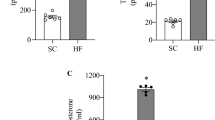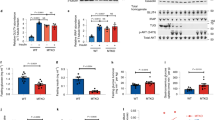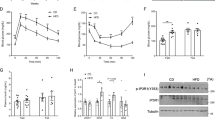Abstract
Objective: It has been reported that an increased availability of free fatty acids (NEFA) not only interferes with glucose utilization in insulin-dependent tissues, but may also result in an uncoupling effect of heart metabolism. We aimed therefore to investigate the effect of an increased availability of NEFA on gene expression of proteins involved in transmembrane fatty acid (FAT/CD36) and glucose (GLUT4) transport and of the uncoupling proteins UCP2 and 3 at the heart and skeletal muscle level.
Study Design: Euglycemic hyperinsulinemic clamp was performed after 24 h Intralipid® plus heparin or saline infusion in lean Zucker rats. Skeletal and heart muscle glucose utilization was calculated by 2-deoxy-[1-3H]-D-glucose technique. Quantification of FAT/CD36, GLUT4, UCP2 and UCP3 mRNAs was obtained by Northern blot analysis or RT-PCR.
Results: In Intralipid® plus heparin infused animals a significant decrease in insulin-mediated glucose uptake was observed both in the heart (22.62±2.04 vs 10.37±2.33 ng/mg/min; P<0.01) and in soleus muscle (13.46±1.53 vs 6.84±2.58 ng/mg/min; P<0.05). FAT/CD36 mRNA was significantly increased in skeletal muscle tissue (+117.4±16.3%, P<0.05), while no differences were found at the heart level in respect to saline infused rats. A clear decrease of GLUT4 mRNA was observed in both tissues. The 24 h infusion of fat emulsion resulted in a clear enhancement of UCP2 and UCP3 mRNA levels in the heart (99.5±15.3 and 80±4%) and in the skeletal muscle (291.5±24.7 and 146.9±12.7%).
Conclusions: As a result of the increased availability of NEFA, FAT/CD36 gene expression increases in skeletal muscle, but not at the heart level. The augmented lipid fuel supply is responsible for the depression of insulin-mediated glucose transport and for the increase of UCP2 and 3 gene expression in both skeletal and heart muscle.
This is a preview of subscription content, access via your institution
Access options
Subscribe to this journal
Receive 12 print issues and online access
$259.00 per year
only $21.58 per issue
Buy this article
- Purchase on Springer Link
- Instant access to full article PDF
Prices may be subject to local taxes which are calculated during checkout



Similar content being viewed by others
References
Randle PJ, Garland PB, Hales CN, Newsholme EA . The glucose-fatty acid cycle: its role in insulin insensitivity and the metabolic disturbances of diabetes mellitus Lancet 1963 i: 785–789.
Shulman GI . Cellular mechanisms of insulin resistance J Clin Invest 2000 106: 171–176.
Kahn BB, Flier JS . Obesity and insulin resistance J Clin Invest 2000 106: 473–481.
Ferrannini E, Barret EJ, Bevilacqua S, DeFronzo RA . Effect of fatty acids on glucose production and utilization in man J Clin Invest 1983 72: 1737–1747.
Nuutila P, Koivisto VA, Knuuti J, Ruotsalainen U, Ters M, Haaparanta M . Glucose-free fatty acid cycle operates in human heart and skeletal muscle in vivo J Clin Invest 1992 89: 1767–1774.
Ferrannini E, Santoro D, Bonadonna R, Natali A, Parodi O, Camici PG . Metabolic and hemodynamic effects of insulin on human hearts Am J Physiol 1993 264: E308–E315.
Nicholl TA, Lopashuk GD, McNeill JH . Effects of free fatty acids and dichloroacetate on isolated working diabetic rat heart Am J Physiol 1991 261: H1053–H1059.
Camps M, Castellò A, Muñoz P, Monfar M, Testar X, Palacìn M, Zorzano A . Effect of diabetes and fasting on GLUT4 (muscle/fat) glucose transporter expression in insulin-sensitive tissues. Heterogeneous response in heart, red and white muscle Biochem J 1992 282: 765–772.
Laybutt DR, Thompson AL, Cooney GJ, Kraegen EW . Selective chronic regulation of GLUT1 and GLUT4 content by insulin, glucose, and lipid in rat cardiac muscle in vivo Am J Physiol 1997 273: H1309–H1316.
Luiken JJ, Schaap FG, van Nieuwenhoven FA, van der Vusse GJ, Bonen A, Glatz JF . Cellular fatty acid transport in heart and skeletal muscle as facilitated by proteins Lipids 1999 34 (Suppl): S169–S175.
Sorrentino D, Robinson RB, Kiang CL, Berk PD . At physiologic albumin/oleate concentrations oleate uptake by isolated heptatocytes, cardiac myocytes, and adipocytes is a saturable function of the unbound oleate concentration. Uptake kinetics are consistent with the conventional theory J Clin Invest 1989 84: 1325–1333.
Abumrad NA, El-Maghrabi MR, Amri E, Lopez E, Grimaldi PA . Cloning of a rat adipocyte membrane protein implicated in binding or transport of long-chain fatty acids that is induced during preadipocyte differentiation J Biol Chem 1993 268: 17665–17668.
Sfeir Z, Ibrahimi A, Amri E, Grimaldi P, Abumrad NA . Regulation of FAT/CD36 gene expression: further evidence in support of a role of the protein in fatty acid binding/transport Prost Leuk Essent Fatty Acids 1997 57: 17–21.
Bonen A, Dyck DJ, Ibrahimi A, Abumrad NA . Muscle contractile activity increases fatty acid metabolism and transport and FAT/CD36 Am J Physiol 1999 276: E642–E649.
Nisoli E, Carruba MO, Tonello C, Macor C, Federspil G, Vettor R . Induction of fatty acid translocase/CD36, peroxisome proliferator-activated receptor-gamma2, leptin, uncoupling proteins 2 and 3, and tumor necrosis factor-alpha gene expression in human subcutaneous fat by lipid infusion Diabetes 2000 49: 319–324.
Van der Lee KA, Vork MM, De Vries JE, Willemsen PH, Glatz JF, Reneman RS, Van Der Vusse GJ, Van Bilsen M . Long-chain fatty acid-induced changes in gene expression in neonatal cardiac myocytes J Lipid Res 2000 41: 41–47.
Dedukhova VI, Mokhova EN, Skulachev VP, Starkov AA, Arrigoni-Martelli E, Bobyleva VA . Uncoupling effect of fatty acids on heart muscle mitochondria and submitochondrial particles FEBS Lett 1991 295: 51–54.
Simonyan RA, Skulachev VP . Thermoregulatory uncoupling in heart muscle mitochondria: involvement of the ATP/ADP antiporter and uncoupling protein FEBS Lett 1998 436: 81–84.
Hidaka S, Kakuma T, Yoshimatus H, Yasunaga S, Kurokawa M, Sakata T . Molecular cloning of rat uncoupling protein 2 cDNA and its expression in genetically obese Zucker fatty (fa/fa) rats Biochim Biophys Acta 1998 1389: 178–181.
Gong D-W, He Y, Karash M, Reitman M . Uncoupling protein-3 is a mediator of thermogenesis regulated by thyroid hormone, beta3-adrenergic agents, and leptin J Biol Chem 1997 272: 24129–24132.
Boss O, Samec S, Paoloni-Giacobino A, Rossier C, Dulloo A, Seidoux J, Muzzin P, Giacobino J-P . Uncoupling protein-3: a new member of the mitochondrial carrier family with tissue-specific expression FEBS Lett 1997 408: 39–42.
Vidal-Puig A, Solanes G, Grujic D, Flier JS, Lowell BB . UCP3: an uncoupling protein homologue expressed preferentially and abundantly in skeletal muscle and brown adipose tissue Biochem-Biophys Res Commun 1997 235: 79–82.
Allison TB, Brutting SP, Crass MF III Eliot RS, Shipp JC . Reduced high-energy phosphate levels in rat hearts: (1) effect of alloxan diabetes Am J Physiol 1976 230: 1744–1750.
Hidaka S, Kakuma T, Yoshimatsu H, Sakino H, Fukuchi S, Sakata T . Streptozotocin treatment upregulates uncoupling protein 3 expression in the rat heart Diabetes 1999 48: 430–435.
DeFronzo RA, Tobine JD, Andres R . Glucose clamp technique: a method for quantifying insulin secretion and resistance Am J Physiol 1979 237: E214–E223.
Ferré P, Burnol AFF, Leturque A, Terrettaz J, Penicaud L, Jeanrenaud B, Girard J . Glucose utilization in vivo and insulin-sensitivity of rat brown adipose tissue in various physiological and pathological conditions Biochem J 1985 233: 249–252.
James DE, Jenkins AB, Kraegen W . Heterogeneity of insulin action on individual muscles in vivo: euglycemic clamp studies in rats Am J Physiol 1985 248: E567–E574.
Chomczynski P, Sacchi N . Single-step method of RNA isolation by acid guanidinium thiocyanate–phenol–chloroform extraction Anal Biochem 1987 162: 156–159.
Postic C, Leturque A, Rencurel F, Printz RL, Forest C, Granner DK, Girard J . The effects of hyperinsulinemia and hyperglycemia on GLUT4 and Hexokinase II mRNA and protein in rat skeletal muscle and adipose tissue Diabetes 1993 42: 922–929.
Gaudette MF, Crain WR . A simple method for quantifying mRNAs in small numbers of early mouse embryos Nucleic Acids Res 1991 19: 1879–1884.
Furler SM, Cooney GJ, Hegarty BD, Lim-Fraser MY, Kraegen EW, Oakes ND . Local factors modulate tissue-specific NEFA utilizatioin: assessment in rats using 3H-(R)-2-bromopalmitate Diabetes 2000 49: 1427–1433.
Coburn CT, Knapp FF Jr Febbraio M, Beets AL, Silverstein RL, Abumrad NA . Defective uptake and utilization of long chain fatty acids in muscle and adipose tissues of CD36 knockout mice J Biol Chem 2000 275: 32523–32529.
Luiken JJ, Turcotte LP, Bonen A . Protein-mediated palmitate uptake and expression of fatty acid transport proteins in heart giant vesicles J Lipid Res 1999 40: 1007–1016.
Glatz JFC, van Nieuwenhoven FA, Luiken JJFP, Schaap GF, van der Vusse GJ . Role of membrane-associated and cytoplasmic fatty acid-binding proteins in cellular fatty acid metabolism Prost Leuk Essent Fatty Acids 1997 57: 373–378.
Luiken JJ, Arumugam Y, Dyck DJ, Bell RC, Pelsers MM, Turcotte LP, Tandon NN, Glatz JF, Bonen A . Increased rates of fatty acid uptake and plasmalemmal fatty acid transporters in obese Zucker rats J Biol Chem 2001 276: 40567–40573.
Garvey WG, Hardiin D, Juhaszova M, Dominguez JH . Effects of diabetes on myocardial glucose transport system in rats: implicatioin for diabetic cardiomyopathy Am J Physiol 1993 264: 837–844.
Zierath JR, Houseknecht KL, Gnudi L, Kahn BB . High-fat feeding impairs insulin-stimulated GLUT4 recruitment via an early insulin-signaling defect Diabetes 1997 46: 215–223.
Kahn BB, Pedersen O . Suppression of GLUT4 expression in skeletal muscle of rats that are obese from high fat feeding but not from high carbohydrate feeding or genetic obesity Encrocrinology 1993 132: 13–22.
Kim Y, Tamura T, Iwashita S, Tokuyama K, Suzuki M . Effect of high-fat diet on gene expression of GLUT4 and insulin receptor in soleus muscle Biochem Biophys Res Commun 1994 202: 519–526.
Sevilla L, Guma A, Enrique-Tarancon G, Mora S, Munoz P, Palacin M, Testar X, Zorzano A . Chronic high-fat feeding and middle-aging reduce in an additive fashion Glut4 expression in skeletal muscle and adipose tissue Biochem Biophys Res Commun 1997 235: 89–93.
Weiss JN, Lamp ST . Glycolysis preferentially inhibits ATP-sensitive K+ channels in isolated guinea pig cardiomyocytes Science 1987 238: 67–69.
Hendrickson S, St Louis JD, Lowe JE . Free fatty acid metabolism during myocardial ischemia and reperfusion Mol Cell Biochem 1997 166: 85–94.
Belke DD, Larsen TS, Gibbs EM, Severson DL . Altered metabolism causes cardiac dysfunction in perfused hearts from diabetic (db/db) mice Am J Physiol 2000 279: E1104–E1113.
Schonfeld P, Schld L, Kunz W . Long-chain fatty acids as protonophoric uncouplers of oxidative phosphorylation in rat liver mitochondria Biochem Biophys Acta 1989 977: 266–272.
Rottemberg H, Hashimoto K . Fatty acid uncoupling of oxidative phosphorylation in rat liver mitochondria Biochemistry 1986 25: 1747–1755.
Wojtezak L, Schonfeld P . Effect of fatty acids on energy coupling processes in mitochondria Biochim Biophys Acta 1993 1183: 41–57.
Samec S, Seydoux J, Duloo A . Interorgan signalling between brown adipose tissue metabolism and skeletal muscle uncoupling protein homologues: is there a role for circulating fatty acids Diabetes 1998 47: 298–302.
Weigle DS, Selfbridge LE, Schwartz MW, Seeley RJ, Cummings DE, Havel PJ, Kuiper JL, Beltran del Rio H . Elevated free fatty acids induce uncoupling protein 3 expression, in muscle Diabetes 1998 47: 298–302.
Van Der Lee KA, Willemsen PH, Samec S, Seydoux J, Dulloo AG, Pelsers MM, Glatz JF, Van Der Vusse GJ, Van Bilsen M . Fasting-induced changes in the expression of genes controlling substrate metabolism in the rat heart J Lipid Res 2001 42: 1752–1758.
Van Der Lee KA, Willemsen P, Van Der Vusse GJ, Van Bilsen M . Effects of fatty acids on uncoupling protein-2 expression in the rat heart FASEB J 2000 14: 495–502.
Allison TB, Brutting SP, Crass MF III Eliot RS, Shipp JC . Reduced high-energy phosphate levels in rat hearts: (1) effect of alloxan diabetes Am J Physiol 1976 230: 1744–1750.
Samec S, Seydoux J, Dulloo AG . Role of UCP homologues in skeletal muscles and brown adipose tissue: mediators of thermogenesis or regulators of lipids as fuel substrate? FASEB J 1998 12: 715–724.
Kageyama H, Suga A, Kashiba M, Oka J, Osaka T, Kashiwa T, Hirano T, Nemato K, Namba Y, Ricquier D, Giacobino JP, Inoue S . Increased uncoupling protein-2 and -3 gene expression in skeletal muscle of STZ-induced diabetic rats FEBS Lett 1998 440: 450–453.
Himms-Hagen J, Harper ME . Physiological role of UCP3 may be export of fatty acids from mitochondria when fatty acid oxidation predominates: an hypothesis Exp Biol Med 2001 226: 78–84.
Negre-Salvayre A, Hirtz C, Carrera G, Cazenave R, Troly M, Salvayre R, Penicaud L, Casteilla L . A role for uncoupling protein-2 as a regulator of mitochondrial hydrogen peroxide generation FASEB J 1997 11: 809–815.
Boss O, Hagen T, Lowell BB . Uncoupling proteins 2 and 3: potential regulators of mitochondrial enery metabolism Diabetes 2000 49: 143–156.
Acknowledgements
This work was supported by a grant of ‘Ricerca Finalizzata della Regione Veneto’ and by MURST (Ministero della Ricerca Scientifica e Tecnologica) grant no. 9806241798006 to GF and grant no. 980624179800 to MOC. We thank Mrs Marilena Tormene and Mrs Sonia Leandri for the expert technical assistance.
Author information
Authors and Affiliations
Corresponding author
Rights and permissions
About this article
Cite this article
Vettor, R., Fabris, R., Serra, R. et al. Changes in FAT/CD36, UCP2, UCP3 and GLUT4 gene expression during lipid infusion in rat skeletal and heart muscle. Int J Obes 26, 838–847 (2002). https://doi.org/10.1038/sj.ijo.0802005
Received:
Revised:
Accepted:
Published:
Issue Date:
DOI: https://doi.org/10.1038/sj.ijo.0802005
Keywords
This article is cited by
-
Mitochondrial oxidative metabolism and uncoupling proteins in the failing heart
Heart Failure Reviews (2015)
-
GLUT4 content decreases along with insulin resistance and high levels of inflammatory markers in rats with metabolic syndrome
Cardiovascular Diabetology (2012)
-
Inhibition of uncoupling protein 2 with genipin exacerbates palmitate-induced hepatic steatosis
Lipids in Health and Disease (2012)
-
Chronic akt activation accentuates aging-induced cardiac hypertrophy and myocardial contractile dysfunction: role of autophagy
Basic Research in Cardiology (2011)
-
A high fat diet increases mitochondrial fatty acid oxidation and uncoupling to decrease efficiency in rat heart
Basic Research in Cardiology (2011)



